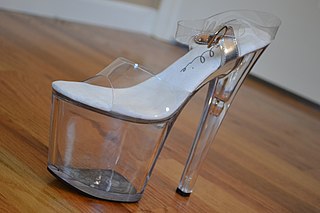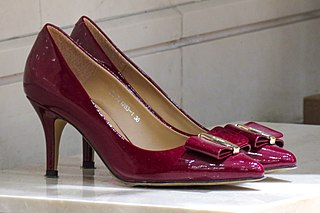
A shoe is an item of footwear intended to protect and comfort the human foot. Though the human foot can adapt to varied terrains and climate conditions, it is vulnerable, and shoes provide protection. Form was originally tied to function, but over time, shoes also became fashion items. Some shoes are worn as safety equipment, such as steel-toe boots, which are required footwear at industrial worksites.

Footwear refers to garments worn on the feet, which typically serve the purpose of protection against adversities of the environment such as wear from rough ground; stability on slippery ground; and temperature.

In modern usage, hijab generally refers to various head coverings conventionally worn by many Muslim women. It is similar to the tichel or snood worn by Orthodox Jewish women, certain headcoverings worn by some Christian women, such as the mantilla, apostolnik and wimple, and the dupatta worn by many Hindu and Sikh women. Whilst a hijab can come in many forms, it often specifically refers to a scarf wrapped around the head, covering the hair, neck and ears but leaving the face visible. The use of the hijab has been on the rise worldwide since the 1970s and is viewed by many Muslims as expressing modesty and faith; it has also been worn for purposes of adornment. There is a consensus among Islamic religious scholars that covering the head is either required or preferred, though some Muslim scholars and activists point out that it is not mandated.

Platform shoes are shoes, boots, or sandals with a thick sole, usually in the range of 5–10 cm (2–4 in). Platform shoes may also be high heels, in which case the heel is raised significantly higher than the ball of the foot. Extreme heights, of both the sole and heel, can be found in fetish footwear such as ballet boots, where the sole may be up to 20 cm (8 in) high and the heels up to 40 cm (16 in) or more. The sole of a platform shoe can have a continuous uniform thickness, have a wedge, a separate block or a stiletto heel. Raising the ankle increases the risk of a sprained ankle.

Thigh-high boots, known also as thigh-length boots or simply thigh boots, are boots that extend above the knees to at least mid-thigh. Other terms for this footwear include over-the-knee boots, a name originally used for 15th century riding boots for men. These are sometimes called pirate boots, especially when cuffed. Over-the-knee boots are sometimes abbreviated to OTK boots. Lengths vary from reaching just over the knee to reaching almost to the crotch.

A dress code is a set of rules, often written, with regard to what clothing groups of people must wear. Dress codes are created out of social perceptions and norms, and vary based on purpose, circumstances, and occasions. Different societies and cultures are likely to have different dress codes, Western dress codes being a prominent example.

Sandals are an open type of shoe, consisting of a sole held to the wearer's foot by straps going over the instep and around the ankle. Sandals can also have a heel. While the distinction between sandals and other types of footwear can sometimes be blurry, the common understanding is that a sandal leaves all or most of the foot exposed. People may choose to wear sandals for several reasons, among them comfort in warm weather, economy, and as a fashion choice. Usually, people wear sandals in warmer climates or during warmer parts of the year in order to keep their feet cool and dry. The risk of developing athlete's foot is lower than with enclosed shoes, and the wearing of sandals may be part of the treatment regimen for such an infection.

A kitten heel is a short stiletto heel less than 5cm in height, with a slight curve setting the heel in from the back edge of the shoe. The style was popularized by Audrey Hepburn in 1964, and more recent followers of the fashion as of 2010 were Theresa May, Michelle Obama, and Hillary Clinton.

Winklepickers or winkle pickers are a style of shoe or boot worn from the 1950s onward, especially popular with British rock and roll fans such as teddy boys. The feature that gives both the boot and shoe their name is the very sharp and long pointed toe, reminiscent of medieval footwear and approximately the same as the long pointed toes on some women's high-fashion shoes and boots in the 2000s. They are still popular in the goth, raggare and rockabilly subcultures.

Leggings are several types of leg attire that have varied through the years. Modern usage from the 1960s onwards has come to refer to elastic close-fitting high-rise garments worn over the legs typically by women, such as leg warmers or tights. Usage from the 18th century refers to men's wear usually made of cloth or leather that is wrapped around the leg down to the ankle. In the 19th century, leggings usually referred to infants' leg clothing that were matched with a jacket, as well as leg-wrappings made of leather or wool and worn by soldiers and trappers. Leggings prominently returned to women's fashion in the 1960s, drawing from the form-fitting clothing of dancers. With the widespread adoption of the synthetic fibre Lycra and the rise in popularity of aerobics, leggings came to further prominence in the 1970s and 1980s, and eventually made their way into streetwear. Leggings are a part of the late 2010s into the 2020s athleisure fashion trend of wearing activewear outside sporting activities and in casual settings.

A stiletto heel, or just stiletto, is a shoe with a long, thin, high heel. It is named after the stiletto dagger.

High-heeled shoes, also known as high heels or pumps, are a type of shoe with an upward-angled sole. The heel in such shoes is raised above the ball of the foot. High heels cause the legs to appear longer, make the wearer appear taller, and accentuate the calf muscle.

Christian Louboutin is a French fashion designer. His stiletto footwear incorporates shiny, red-lacquered soles that have become his signature. Initially a freelance designer for fashion houses, he started his shoe salon in Paris, with his shoes finding favor with celebrity clientele. He has partnered with other organizations for projects including limited edition pieces, gallery exhibits, and a custom bar. His company has since branched out into men's luxury footwear, handbags, fragrances, and makeup.

Smart casual is an ambiguously defined Western dress code that is generally considered casual wear but with smart components of a proper lounge suit from traditional informal wear. For men, this interpretation typically includes dress shirt, necktie, trousers, and dress shoes, possibly worn with an odd-coloured blazer or a sports coat.

A court shoe or pump is a shoe with a low-cut front, or vamp, with either a shoe buckle or a black bow as ostensible fastening. Deriving from the 17th- and 18th-century dress shoes with shoe buckles, the vamped pump shape emerged in the late 18th century. By the turn of the 19th century, shoe buckles were increasingly replaced by black bows, which has remained the contemporary style for men's formal wear, leather or patent leather evening pumps ever since. This latter style is sometimes also called an opera pump or opera slipper.

Trousers or pants are a staple of historical and modern fashion. Throughout history, the role of trousers is a constant change for women. The first appearance of trousers in recorded history is among nomadic steppe-people in Western Europe. Steppe people were a group of nomads of various different ethnic groups that lived in the Eurasian grasslands. Archaeological evidence suggests that men and women alike wore trousers in that cultural context. However, for much of modern history, the use of trousers has been restricted to men. This norm was enforced in many regions due to social customs and laws. There are, however, many historical cases of women wearing trousers in defiance of these norms such as the 1850s women rights movement, comfort, freedom of movement, fashion, disguise, attempts to evade the gender pay gap, and attempts to establish an empowered public identity for women. Especially in the 20th and 21st centuries, the customs and laws restricting this manner of dress have relaxed dramatically, reflecting a growing acceptance and normalisation of the practice.

A slingback is a type of woman's footwear characterized by an ankle strap that crosses only around the back and sides of the ankle and heel, whereas a typical strap completely encircles the ankle all the way around it. It typically has a low vamp front similar to that of classic full shoe heels.
Nicola Sian Thorp is an English broadcaster, columnist, activist, and former actress. She is known for her role as Nicola Rubinstein in the ITV soap opera Coronation Street (2017–2019), as well as her contributions to the newspaper Metro and the programmes This Morning and Talk Today.
The #KuToo movement is an ongoing movement in Japan against the high heel policy in workplaces. The name is a reference to the Me Too movement and a play on words with kutsu and kutsū.

A cosmetics policy is a policy concerning the wearing of cosmetics, which may be required or forbidden in different places and circumstances. A cosmetics policy that applies to only one sex, such as a policy requiring women to wear lipstick or a policy forbidding men to wear nail polish, is considered a form of sex discrimination by some critics. Sex-specific cosmetics policies may place burdens on women workers and may also present difficulties for transgender and non-binary people. Sex-specific cosmetics policies are legal in many jurisdictions.



















